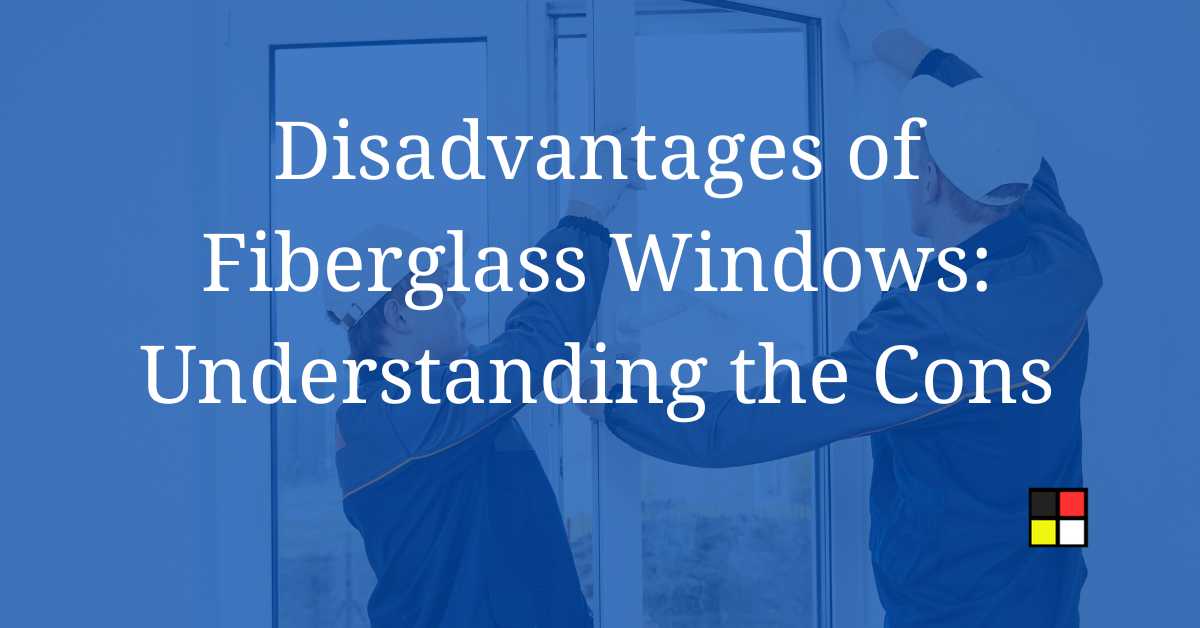Fiberglass windows, often selected for their durability and energy efficiency, have gained popularity as an alternative to traditional wood or vinyl windows.
Despite these advantages, you need to be aware of potential downsides before making a decision. These windows come with certain drawbacks, which may influence your overall satisfaction and long-term comfort in your home.
High installation and maintenance costs can make fiberglass windows a less economical option, especially when budget is a primary consideration.
Furthermore, limitations in color and style choices might restrict your ability to match these windows to your home’s aesthetic. While they are known for their strength, fiberglass windows can also experience issues such as water leakage, color fading, and less-than-optimal thermal and acoustic insulation over time.
Key Takeaways
- Cost factors can make fiberglass windows less appealing.
- Style selections for fiberglass windows are not as varied.
- Performance can diminish due to environmental exposure.
Durability Concerns
When considering fiberglass windows for your home, it’s important to be aware of certain durability issues that can arise over time. These concerns mainly revolve around their reaction to weather and their structural integrity.
Susceptibility to Weathering
Though fiberglass windows are designed to be tough against the elements, they are not entirely immune to weathering. Over extended periods, exposure to harsh weather conditions can affect the performance and appearance of your windows.
For instance, in climates with long winter seasons and humid summers, repeated cycles of freezing and thawing can contribute to the degradation of the window material, potentially resulting in reduced energy efficiency or aesthetic appeal.
Potential for Cracking and Fracturing
Fiberglass windows are generally strong, but under certain conditions, they might develop cracks or fractures. Stress from thermal expansion or contraction can lead to such problems, especially if the windows are not properly installed.
While less likely than other materials, severe impacts or strain can also lead to damage, which can be an expensive problem to address.
Maintenance and Repair
In evaluating the downsides of fiberglass windows, it is essential to consider both their potential difficulty in repair and the reality of their long-term maintenance.
Difficulty in Repair
When your fiberglass windows require repairs, the process can be more complex than with other materials. Frames may not easily accept new paint or patching materials, which means a simple touch-up may not suffice.
According to Today’s Homeowner, damaged frames, as well as warping and peeling paint, are common issues requiring professional attention. This could lead to higher maintenance costs over the window’s lifespan.
Long-Term Maintenance
Fiberglass windows are often celebrated for their durability and resistance to weather-related expansion and contraction. However, you should be aware that while they may resist warping or cracking, issues like water leakage can occur, as noted by Brennan Corp.
This kind of maintenance challenge sometimes results in the need for resealing or, in more severe cases, complete replacement of affected parts. Regular checks for seal integrity and frame condition can help mitigate such issues, but they add to your long-term maintenance tasks.
Aesthetic Limitations
When considering fiberglass windows, you should be mindful of the aesthetic constraints that may impact the appearance and integration into your home’s design.
Limited Customization Options
Fiberglass windows may present fewer styling options compared to other materials like wood or vinyl. You’re likely to find a limited range of shapes, sizes, and finishes, which can impact your ability to match them with your home’s unique architecture.
Color Fading Over Time
Over the years, the color of your fiberglass windows might fade due to prolonged exposure to sunlight. While the material itself is durable, this can lead to a less vibrant appearance, necessitating potential refinishing to restore the original hue.
Thermal and Acoustic Insulation
When considering fiberglass windows, you must be aware that they may not offer the best performance in terms of thermal and acoustic insulation compared to other materials.
Inferior Insulation Properties
Fiberglass windows may not provide the same level of thermal efficiency as other window types. While they are more affordable, they tend to have a lower R-value, meaning their insulating capabilities are less efficient. Your home may lose more heat during winter and gain more heat during summer, which can lead to increased energy costs.
Poor Noise Reduction
As for sound insulation, fiberglass windows may not offer the best noise reduction. The material is not as dense as alternatives like vinyl or wood, which means it is less effective at dampening external sounds.
If you live in a noisy environment, you might find that fiberglass windows do not significantly reduce the intrusion of unwanted noise into your home.
Environmental Impact
When considering the environmental drawbacks of fiberglass windows, your focus may turn to the long-term effects of the materials used and the production process. The following subsections will detail specific environmental concerns.
Non-Biodegradable Material
Fiberglass windows contain glass fibers set in resin, which are not biodegradable. If disposed of in a landfill, your fiberglass windows could remain intact for centuries, thereby contributing to environmental pollution.
Energy Intensive Manufacturing
The manufacturing of fiberglass windows is an energy-intensive process. It requires high temperatures to mold and cure the resin around the glass fibers. Consequently, the production of fiberglass windows demands a notable amount of energy, which can indirectly increase the emission of greenhouse gases.
Frequently Asked Questions
In your pursuit of home improvement, it’s essential to weigh the pros and cons. Here are answers to some common queries about fiberglass windows that may help inform your decision.
What are the potential drawbacks of installing fiberglass windows?
Fiberglass windows can be more costly upfront compared to other materials. Issues like damaged frames, warping, and peeling paint are also potential drawbacks that could affect their performance and appearance.
Can fiberglass windows suffer from wear and leaks over time?
Yes, like any window, fiberglass models may experience wear and leaks over time, particularly if not properly installed or maintained.
How do fiberglass window costs compare with wood window costs?
On average, fiberglass windows are more expensive than wood windows. The initial investment may be higher, but you should also consider the long-term durability and energy efficiency.
What is the expected lifespan and durability of fiberglass windows?
Fiberglass windows are generally known for their durability and long lifespan, often outlasting other window materials when properly maintained.
Is there a risk of cracking with fiberglass windows in certain climates?
While fiberglass is resilient, extreme temperature fluctuations in some climates might lead to a higher rate of expansion and contraction, which could potentially cause cracking over time.
What maintenance concerns should be considered with fiberglass windows?
Minimal maintenance is required for fiberglass windows. However, regular cleaning and occasional inspections for sealant failures are advisable to ensure their longevity.






